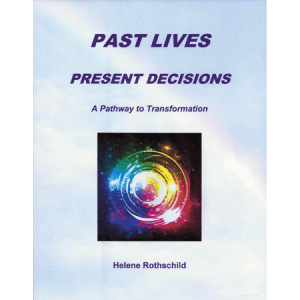 Reviewed by Marilyn J. Wulff, M.S.W.
Reviewed by Marilyn J. Wulff, M.S.W.
In JRT Issue 10, Fall 1992
Helene Rothschild’s book, Past Lives, Present Decisions, would be an excellent resource for beginning past-life therapists and I believe is designed to serve as a self-help guide to individuals who are ready to learn more about and experience their past lives, as a “pathway to transformation.”
Rothschild, who has a Master’s Degree in Marriage, Family, and Child Counseling, and is in private practice in California, describes her approach as being based upon what she calls “Creative Therapy,” saying “…we all make decisions based on our experiences. These decisions or thoughts control our lives,” and adds that another principle of her therapy is “we are all totally responsible for our lives. There are no victims. There are only volunteers.”
Helene Rothschild describes how she utilizes past-life exploration to help her clients “free their Scared Inner Child.” Utilizing Creative Visualization techniques, she assists her clients to reach a level of relaxation and then guides them to meet a “Wise Person” (their intuitive or Higher Self) who acts as an assistant to answer questions, guide, and protect the past-life participant.
The author begins the book by describing her own experiences with past lives. In her current life she had felt “held back” from helping others. In these explorations she found herself in many past-life situations in which she helped others to fight social injustice and, as a result, she was persecuted or killed—thus leaving her with a powerful internal message to “be careful to not be too powerful or helpful.” It seems apparent that despite the author’s past-life fears, she has claimed her power in this incarnation, and is utilizing her skills to lead people to freedom and help them heal themselves.
After offering her own personal story and explanation of her Creative Therapy process, the author goes on to give twelve case examples from her private practice. Throughout these case examples, Ms. Rothschild not only assists her clients in observing and rediscovering past-life occurrences, but she also helps them release negative perceptions from past-life events and create new positive experiences. She explains that “since you make decisions based upon your experiences, you can easily make new positive decisions based upon imagined experiences. Even if the experience isn’t real, your inner mind will respond as if it were.” The author adds, “You can literally rewrite your past and change your feelings and behavior in the future.” The technique of creating a more positive image of an experience, rather than just focusing on remembering the disturbing past-life events and feelings seems to be a helpful therapeutic tool, according to the author. One example given is the story of Kate, who finds herself in a past life in Massachusetts during the witch hunts (circa 1692). She is imprisoned with many other women, and then finds herself in a courtroom. She reports:
Lots of men were staring at me with angry faces and were accusing me of witchcraft. They said I was evil. Terrified, I put my hands over my face and sobbed uncontrollably. They showed no mercy. The angry mob dragged me outside and hanged me alongside three other condemned witches.
Kate reported that this past-life regression helped her understand why, in her present life, she can’t wear anything close to her neck, and why she avoids crowds and lives in the country, away from people. In her current life, Kate has been a loner and a perpetual student. She says she has felt safer being a follower. “I’ve always avoided being a leader at all costs, even though I’m capable of leadership.” As a result of this session with Rothschild, Kate decided that she was ready to “come out of hiding” and express herself. With Rothschild’s assistance Kate was able to face her accusers, by visualizing the witch hunters, and then expressed her feelings to them.
I yelled and screamed at them because I was furious and terrified. I cried to release my hurt and sadness. As soon as I felt relaxed I changed the scene. My new image was of the same men in front of me, but this time they were listening with respect and admiration. They appreciated my healing abilities and thanked me for all my help. My body relaxed even more and I felt safe. From that new experience I was able to make a new decision: I am beginning to believe that it is safe for me to be me.
Rothschild uses case examples to demonstrate the personal and interpersonal benefits of past-life therapy for her clients. The scenarios described, all having positive outcomes, are affirming and encouraging to the reader—giving a feeling of hope, out of seemingly emotionally disabling past-life circumstances. According to the author, forgiving and letting go is an important part of the past-life experience.
It might be noted that Rothschild does not give any examples of clients who had either negative or neutral experiences with her techniques. It is not clear whether all her clients benefited from their past-life experiences or whether she chose not to include a discussion of clients who may not have been helped from past-life therapy.
Overall, Past Lives, Present Decisions, is an easy-to-read book, filled with case examples of personal and spiritual growth, with an overall message of hope. This book would be a good resource to share with clients who are questioning what past-life experiences are like, and it gives reassurance to prospective past-life participants that remembering and releasing emotions and experiences from past lives can have beneficial and long-lasting outcome.
